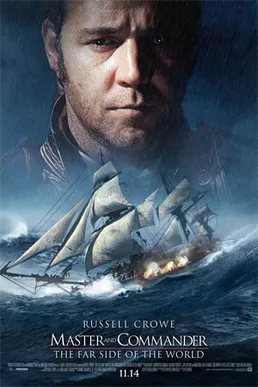Historical accuracy of Master and Commander

Historical accuracy of Master and Commander

Book
The relationship between Captain Aubrey and Dr. Maturin
The film captures the complex and nuanced relationship between Captain Jack Aubrey and Dr. Stephen Maturin, including their contrasting personalities, their intellectual discussions, and their mutual respect. This relationship is central to the film and is faithful to the spirit of the novels.
The scientific pursuits of Dr. Maturin
The film highlights Dr. Maturin's scientific interests and his observations of the natural world, including his exploration of the Galapagos Islands. This aspect of his character is consistent with the novels and historical context.
Characters
The characters are fictional
All the characters are fictional
Story
The pursuit of the French frigate 'Acheron'
The pursuit of the French frigate 'Acheron' is a key plot element, but the specific details of the chase and the engagements are fictionalized. The 'Acheron' itself is a composite of several real French ships, and the specific events are invented for the narrative.
Setting
Naval warfare tactics of the Napoleonic era
The film accurately portrays the tactics used in naval battles during the Napoleonic Wars, including broadsides, boarding actions, and the use of cannons. The maneuvers and strategies employed are generally consistent with historical understanding.
Life aboard a British naval vessel
The film provides a realistic depiction of life aboard a British naval vessel, including the daily routines, the cramped conditions, the food, and the social hierarchy. The details of shipboard life are well-researched and contribute to the film's authenticity.
The depiction of scurvy
The film accurately portrays the devastating effects of scurvy on sailors and the importance of citrus fruits in preventing it. The film's depiction of the disease and its treatment is consistent with historical understanding.
The use of the 'surprise' tactic
The use of the 'surprise' tactic, where a ship would approach an enemy vessel from an unexpected direction, is historically accurate and was a common naval maneuver. The film's depiction of this tactic is consistent with historical practice.
The portrayal of shipboard surgery
The film provides a realistic, albeit often graphic, depiction of shipboard surgery during the Napoleonic era. The limited medical technology and the harsh conditions under which operations were performed are accurately represented.
The social class distinctions within the Royal Navy
The film accurately portrays the strict social class distinctions within the Royal Navy, from the officers to the enlisted sailors. The hierarchy and the different experiences of individuals based on their social standing are well-represented.
The role of superstition among sailors
The film acknowledges the role of superstition among sailors, including their beliefs about luck, omens, and sea monsters. This aspect of naval culture is woven into the narrative and adds to the film's authenticity.
The depiction of the Galapagos Islands
The film accurately portrays the unique flora and fauna of the Galapagos Islands, which adds to the film's visual appeal and its sense of adventure. The importance of the islands for scientific discovery is also acknowledged.
The use of signal flags in naval communication
The film shows the use of signal flags for communication between ships, which was a crucial aspect of naval tactics during the Napoleonic era.
The depiction of the 'sea dogs' and their camaraderie
The film captures the camaraderie and the rough-and-ready nature of the sailors, often called 'sea dogs.' Their loyalty to their shipmates and their shared experiences are realistically portrayed.
Overall
The overall historical accuracy of the film
While the story and characters are mostly fictional, the film is generally considered historically accurate in its portrayal of naval warfare, shipboard life, and the social context of the Napoleonic era. The film's attention to detail and its commitment to authenticity contribute to its success.
